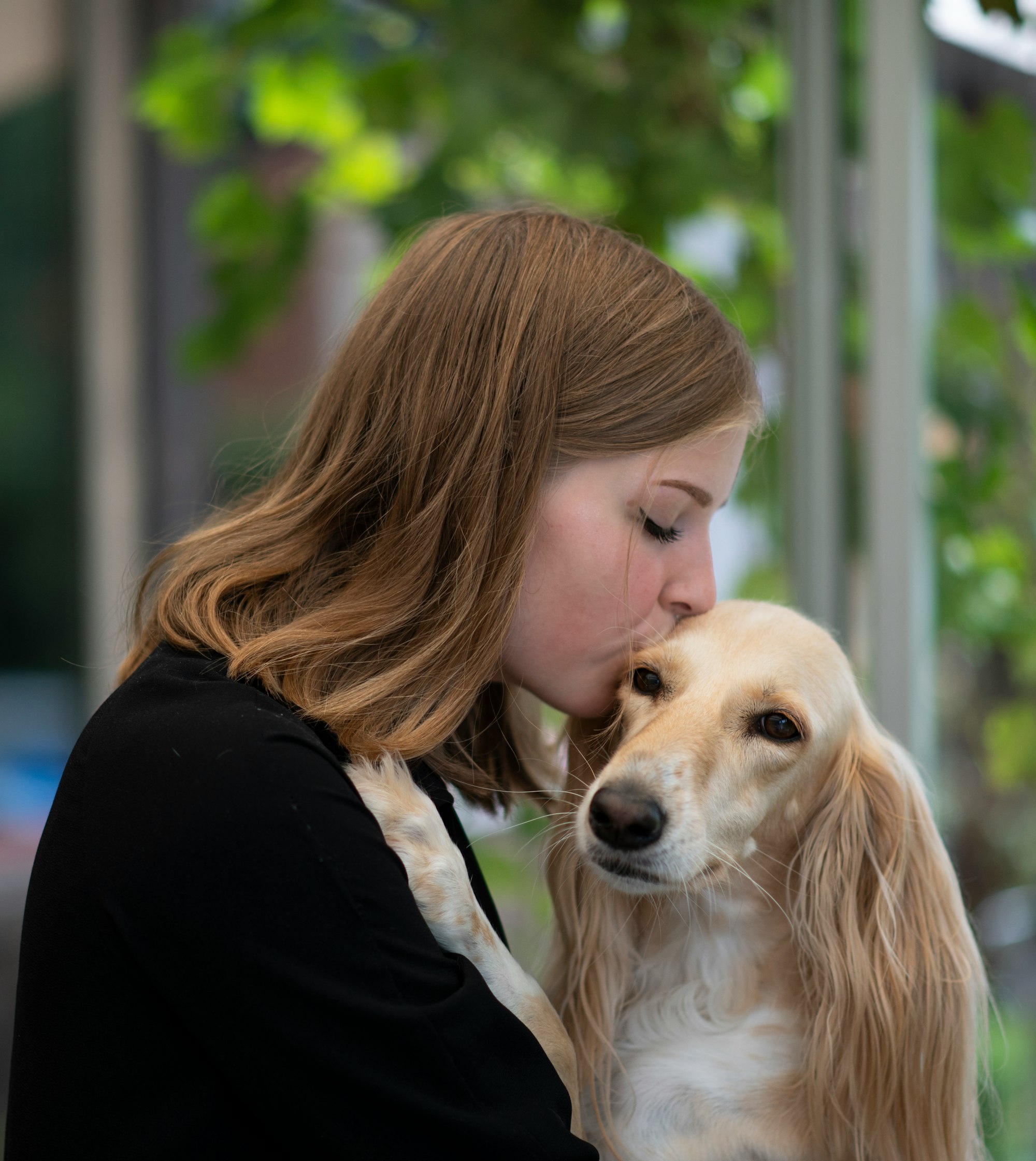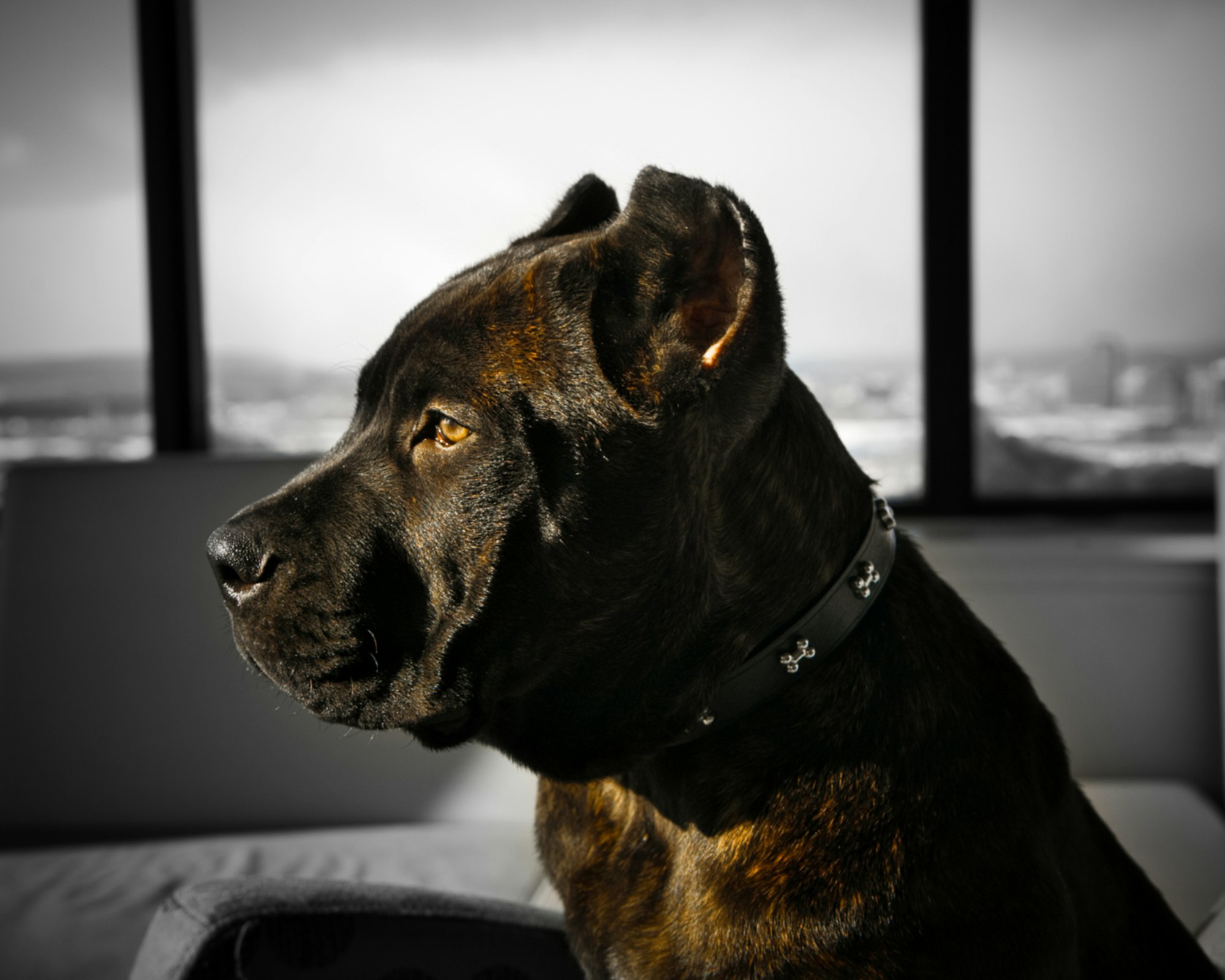The Saluki is a magnificent and ancient breed of dog known for its unique physical characteristics, fascinating history, and distinctive temperament. This elegant sighthound possesses a regal appearance and a sleek, slender body built for speed and agility.

1. Appearance and Size: The Saluki is a tall and graceful dog, standing between 23 to 28 inches (58 to 71 cm) at the shoulder. Its slender frame, long legs, and deep chest contribute to its swift and agile movement.
2. Coat and Colors: Salukis have a smooth and silky coat that can come in various dog coat colors and patterns, including white, cream, fawn, golden, black, and tricolor. They may also have feathering on their ears, tail, and legs.
3. Unique Features: The Saluki is known for its long and narrow head, adorned with large, expressive eyes and drop ears. Its long, slender tail adds to its overall gracefulness.
The history and origins of the Saluki are equally intriguing. This breed can be traced back thousands of years, with evidence of its existence in ancient civilizations such as Egypt and Mesopotamia.

1. Ancient Origins: The Saluki is believed to be one of the oldest dog breeds in existence, with depictions of similar-looking dogs found in ancient Egyptian tombs dating back to 2100 BC.
2. Royal and Noble Connections: Throughout history, Salukis were favored by royalty and nobility, often serving as hunting companions and symbols of wealth and prestige.
3. Spread and Recognition: The breed gradually spread throughout different parts of the world, and in 1923, the Saluki was officially recognized by the American Kennel Club (AKC) in the United States.
Beyond its physical attributes and historical significance, the Saluki possesses a distinct temperament and personality. They are known to be gentle, independent, and sensitive dogs, often developing a strong bond with their owners.
Training and exercise play crucial roles in the well-being of Salukis. These intelligent and athletic dogs require consistent and positive training methods, as well as regular physical and mental exercise to keep them mentally stimulated and physically fit.
While the Saluki is generally a healthy breed, like any dog, they are prone to certain health issues that owners should be aware of. Regular veterinary check-ups, a balanced diet, and appropriate exercise can help prevent or manage these conditions.
Proper grooming and care are essential to keep the Saluki looking its best. Their short, smooth coat is relatively low-maintenance, but regular brushing and occasional bathing are necessary to remove loose hair and maintain cleanliness.
As a family pet, Salukis can be affectionate and loyal companions. They generally get along well with children and other pets if properly socialized and introduced from a young age. However, their independent nature may require proper supervision and training.
The Saluki is undoubtedly a remarkable breed, embodying elegance, history, and unique characteristics that make it a cherished companion for happy dog enthusiasts worldwide.
Key takeaways:
- The Saluki is an ancient breed with royal connections: The Saluki has a long history dating back to ancient times, and it was often associated with royalty and nobility throughout history.
- The Saluki has unique physical characteristics: With its elegant appearance, medium size, and various coat colors, the Saluki stands out among other dog breeds. It also possesses unique features such as a slim body and a long tail.
- The Saluki requires proper training and exercise: Salukis have specific exercise needs, both physically and mentally. Training methods and techniques should be employed to ensure their overall well-being and a happy, well-behaved pet.
Physical Characteristics of the Saluki
With their elegant and graceful appearance, Salukis are renowned for their exceptional physical characteristics. From their stunning coat and colors to their unique features, this section will unveil the fascinating aspects that make the Saluki truly stand out. Get ready to delve into the world of the Saluki's appearance, size, coat variations, and discover what unique features set them apart from other breeds. Get ready to be amazed by the enchanting physical traits of these majestic dogs!
Appearance and Size
| Appearance | Size |
| The Saluki breed has an elegantly built physique, characterized by a slim and athletic body. | Males: 23-28 inches / Females: 22-26 inches |
| It features a long, lean head with a tapered muzzle. | Males: 50-65 pounds / Females: 40-55 pounds |
| One of the notable characteristics of the Saluki is its prominent and expressive oval eyes. | |
| Additionally, it possesses large, folded ears that hang close to the head. | |
| This breed is known for its strong, muscular neck and deep chest. | |
| Salukis have a long and graceful tail with a slight curvature. |
Coat and Colors
The Saluki breed is well-known for its elegant coat and beautiful colors. Below is a table containing detailed information about different coat types and colors:
| Coat Types | Colors |
| Smooth | White, cream, fawn, golden, red, grizzle, black, tricolor |
| Rough | Similar to smooth, but with longer, feathered hair |
Salukis exhibit a wide variety of coat colors, providing an exquisite range of options. Regardless of whether you prefer a smooth or rough coat, you can easily find Salukis available in stunning shades such as white, cream, fawn, golden, red, grizzle, black, and even tricolor combinations. These beautiful colors truly enhance the allure of the Saluki breed, making them highly appealing and desirable for dog enthusiasts.
Unique Features
The Saluki breed is renowned for its unique features that distinguish it from other dog breeds.
- Graceful Appearance: Salukis possess a slim and graceful build, showcasing long legs and a lean body.
- Distinctive Coat: They showcase a sleek and silky coat that can come in various colors, such as white, cream, fawn, and black.
- Prominent Ears: One of their most distinctive traits is their long and pendulous ears, which beautifully frame their face.
- Exceptional Sight: Salukis have extraordinary eyesight and are recognized for their ability to spot prey from remarkable distances.
Pro-tip: To preserve their elegant appearance, it is crucial to provide Salukis with regular grooming.
History and Origins of the Saluki
Have you ever wondered about the captivating history and origins of the Saluki? In this section, we'll take a thrilling journey through time and explore the ancient roots of this majestic breed. We'll also dive into the intriguing connections Salukis have had with royalty and the nobility throughout history. And finally, we'll unravel how these extraordinary dogs spread across different regions and gained recognition for their exceptional qualities. Get ready to uncover fascinating insights into the rich history of the Saluki!

Ancient Origins
The Saluki breed has ancient origins, dating back thousands of years. This elegant dog was highly revered in ancient Egypt and Mesopotamia, showcasing its ancient origins. They were often depicted in art and even buried alongside their owners to accompany them in the afterlife, further emphasizing their ancient origins. The Saluki's heritage as a hunting dog is evident in their slender build, keen sight, and incredible speed, all traits that have been passed down from their ancient origins. Today, Salukis still possess their noble and regal demeanor, making them a popular choice for dog enthusiasts who appreciate their ancient origins. Pro-tip: When owning a Saluki, it's important to provide regular exercise and mental stimulation to keep them happy and healthy and honor their ancient origins.
Royal and Noble Connections
The Saluki breed has a captivating history deeply intertwined with royal and noble connections that span across the ages. Kings, pharaohs, and emperors esteemed these regal canines as symbols of power and prestige.
| Ancient Egypt | In ancient Egypt, Salukis commanded immense reverence. They were frequently portrayed beside pharaohs in tomb paintings and sculptures, signifying their spiritual significance. The ancient Egyptians even mummified them upon their demise. |
| Middle East | Arabian nobility cherished Salukis, considering them an integral part of their families. Bedouin tribes esteemed them as hunting companions, attracted to their unmatched swiftness and grace in pursuing prey. |
| Europe | Salukis enchanted the European aristocracy with their elegance and beauty. They were highly prized as emblems of nobility and often exchanged as precious gifts among royals. These majestic hounds played a significant role in the vibrant court life of European monarchs. |
The Saluki breed's royal and noble connections have played a pivotal role in elevating their status and garnering reverence throughout history. This makes them truly exceptional and highly esteemed.
Spread and Recognition
The spread and recognition of the Saluki breed is a fascinating part of their history. Originally from the Middle East, Salukis were highly valued by nomadic tribes for their hunting skills and loyalty. Gradually, their reputation as exceptional hunting companions spread far and wide, reaching regions like ancient Egypt and Persia. Through the support of royalty and influential connections, Salukis gained widespread recognition and became symbols of status and prestige. In present times, Salukis have achieved recognition from major kennel clubs worldwide, including the American Kennel Club and the Kennel Club in the United Kingdom, solidifying their position as a beloved and esteemed breed.
Temperament and Personality Traits of the Saluki
The Saluki is a gentle and graceful breed known for their calm and reserved nature. They are typically independent and can be aloof with strangers but are loyal and affectionate with their family. Salukis have a strong prey drive due to their history as hunting dogs, making them prone to chasing small animals. They are intelligent and trainable, but can be sensitive and may not respond well to harsh training methods. Owning a Saluki requires patience, consistency, and understanding of their unique temperament and personality traits.
Considering their sensitive nature, here are some suggestions for owning a Saluki:
- Provide plenty of mental and physical stimulation to prevent boredom and destructive behavior.
- Create a safe and secure environment to prevent the Saluki from escaping or chasing after small animals.
- Use positive reinforcement training methods to build a strong bond and trust with your Saluki.
- Socialize your Saluki from an early age to ensure they are comfortable and well-behaved around other animals and people.
Remember, understanding and respecting the temperament and personality traits of the Saluki is crucial for a happy and fulfilling relationship with this wonderful breed.
Training and Exercise for Salukis
Get ready to dive into the world of training and exercise for Salukis! In this section, we'll be exploring the various methods and techniques for training these magnificent creatures. We'll also delve into their physical and mental exercise needs, uncovering the secrets of keeping them fit and happy. So, grab your leash and let's start unleashing the potential of your Saluki companion!

Training Methods and Techniques
| Training Methods and Techniques - Positive Reinforcement | Use treats, praise, and rewards to reinforce desired behaviors during training sessions. This method helps to motivate and build a strong bond with your Saluki. |
| Training Methods and Techniques - Clicker Training | Pairing the sound of a clicker with treats can be an effective way to communicate desired behaviors to your Saluki. The clicker helps to mark the exact moment your dog performs the desired action. |
| Training Methods and Techniques - Consistency | Consistency is crucial in training Salukis. Use the same commands and hand signals consistently to avoid confusion. Stick to a regular training schedule to help your Saluki learn and retain commands. |
| Training Methods and Techniques - Patience | Training a Saluki may take time and patience. Remember to be patient and understanding with your dog as they learn new behaviors. Rushing the process can lead to frustration for both you and your Saluki. |
| Training Methods and Techniques - Socialization | Expose your Saluki to various environments, people, and other animals from a young age. This helps them develop good social skills and become well-rounded dogs. |
Physical and Mental Exercise Needs
To ensure the happiness and health of Salukis, it is crucial to fulfill their physical and mental exercise needs. Salukis require daily opportunities to run and stretch their legs, which can be achieved through long walks, jogs, or play sessions in a securely fenced area. Additionally, Salukis are intelligent dogs that crave mental stimulation. Engaging them with puzzle toys, obedience training, and interactive games can keep their minds sharp and occupied.
To prevent boredom and provide optimum mental and physical stimulation, offering a variety of exercise activities like agility training or lure coursing is beneficial. It is important to remember that Salukis were originally bred as hunting dogs, so meeting their physical and mental exercise needs is vital for their overall well-being and happiness. A content and satisfied Saluki is one that has been adequately exercised both physically and mentally.
Common Health Issues in Salukis
Salukis, although generally healthy, are prone to certain health issues. It's important for potential owners to be aware of these Common Health Issues in Salukis to ensure proper care. Common health issues in Salukis include:
1. Heart conditions: Salukis can be prone to cardiac diseases such as dilated cardiomyopathy.
2. Eye problems: Salukis may develop eye conditions like progressive retinal atrophy.
3. Thyroid disorders: Hypothyroidism and autoimmune thyroiditis are common in this breed.
4. Cancer: Salukis may be susceptible to various types of cancer.
Taking your Saluki for regular check-ups and maintaining a healthy lifestyle can help prevent or manage these Common Health Issues in Salukis.
Pro-tip: Regularly brushing their teeth can help prevent dental problems.
Grooming and Care for Salukis
Grooming and Care for Salukis is essential to maintain their health and appearance. Here are some steps to follow:
- Brush their coat regularlyto remove loose hair and prevent mats.
- Check their ears weeklyand clean them if necessary to prevent infections.
- Trim their nails regularlyto keep them at a manageable length.
- Bathe them occasionally, using a gentle dog shampoo to keep their coat clean.
- Provide regular exerciseto keep them physically and mentally stimulated.
Saluki as a Family Pet
Salukis are not only magnificent hunting companions, but they also make wonderful family pets. Discover the incredible compatibility they have with children and other pets, as well as the optimal living conditions required to keep these regal creatures happy and flourishing. With their gentle demeanor and graceful presence, Salukis can bring immense joy to any household. Let's dive into how they can seamlessly integrate into your family dynamics and the ideal environment for their well-being.
Compatibility with Children and Other Pets
The Saluki breed is highly compatible with both children and other pets, making them a great addition to any family. It is important, however, to consider a few factors before bringing a Saluki into your home:
- Children: Salukis are known for their gentle nature around children, which makes them excellent family pets. To ensure safety, supervision is crucial, especially when younger children are involved.
- Other Pets: Salukis generally have a good relationship with other dogs and cats, as long as they are properly socialized. Gradual introductions and positive experiences will help foster harmonious relationships.
- Training: Early training and socialization are key to teaching Salukis how to interact safely with children and other pets. By starting at a young age, you can ensure that they understand proper behavior.
- Living Space: Salukis thrive in environments with ample space to run and play. A home with a secure yard or access to regular exercise opportunities will provide them with an ideal living situation.
Pro-tip: Always supervise interactions between your Saluki, children, and other pets to maintain a harmonious and safe environment for everyone involved.
Living Conditions
Salukis flourish in homes with spacious living conditions, as they are a big and active breed. They require ample space to stretch their legs and enjoy regular exercise. A fenced yard is ideal for their safety while providing them with sufficient room to run and play. Salukis are not well-suited for apartment living or small spaces.
They need a comfortable environment with access to a soft bed or couch for resting. Please keep in mind that Salukis are sensitive to extreme temperatures, so it is crucial to provide them with a climate-controlled living space. Pro-tip: When setting up the living conditions for a Saluki, make sure the space is secure and appropriate for their size and activity level.

Frequently Asked Questions
- What is the Saluki known for?
- The Saluki is known for being one of the oldest breeds in the world and has a history of being used as a hunting hound by kings. They are renowned for their slim and rugged appearance and their swift and agile sprinting abilities.
- Are Salukis good with chasing?
- Yes, Salukis have a strong instinct for chasing and enjoy a good chase. It is important to provide them with a safe and fenced area or always keep them on a leash when outside.
- What are the characteristics of a Saluki as a pet?
- Despite their independent nature, Salukis are also gentle, dignified, and loyal pets. They make great companions and are known for their overall elegance and graceful appearance.
- How can I find a Saluki from a reliable source?
- When looking for a Saluki, it is advisable to adopt from rescue organizations or shelters. If purchasing from a breeder, it is important to choose a reputable breeder who prioritizes the health and well-being of their dogs and follows ethical breeding practices.
- What is the role of the American Kennel Club (AKC) in Saluki ownership?
- The American Kennel Club (AKC) is a trusted expert in breed, health, and training information for all dogs, including Salukis. They actively promote responsible dog ownership and work towards advancing dog sports. They provide valuable resources for prospective Saluki owners.
- Where did the Saluki originate from?
- The Saluki is believed to have originated in the Fertile Crescent and was used by nomadic tribes in ancient times. It was bred for hunting game animals and has a long-standing history in the Middle East.






